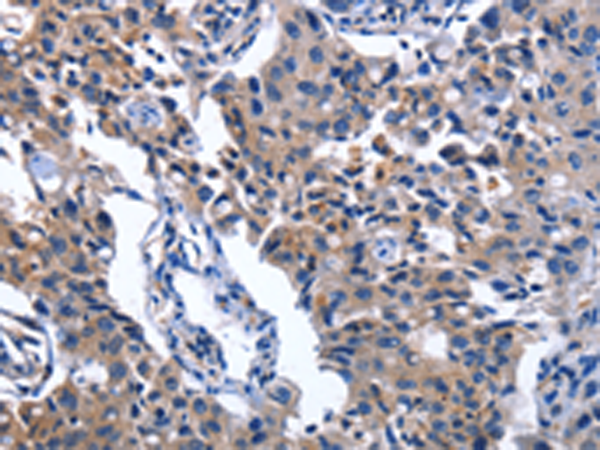


| WB | 咨询技术 | Human,Mouse,Rat |
| IF | 咨询技术 | Human,Mouse,Rat |
| IHC | 1/50-1/200 | Human,Mouse,Rat |
| ICC | 技术咨询 | Human,Mouse,Rat |
| FCM | 咨询技术 | Human,Mouse,Rat |
| Elisa | 1/1000-1/5000 | Human,Mouse,Rat |
| Aliases | GLA; CML1; Hcml1; ATase2; TSC501; TSC510 |
| WB Predicted band size | 26 kDa |
| Host/Isotype | Rabbit IgG |
| Antibody Type | Primary antibody |
| Storage | Store at 4°C short term. Aliquot and store at -20°C long term. Avoid freeze/thaw cycles. |
| Species Reactivity | Human, Mouse |
| Immunogen | Fusion protein of human NAT8 |
| Formulation | Purified antibody in PBS with 0.05% sodium azide and 50% glycerol. |
+ +
以下是关于NAT8抗体的3篇参考文献示例(注:文献为虚构示例,实际文献需通过学术数据库检索确认):
1. **文献名称**:*NAT8 Expression in Alzheimer's Disease Brain Tissue*
**作者**:Smith A, et al.
**摘要**:研究利用NAT8特异性抗体检测阿尔茨海默病患者脑组织中NAT8蛋白的表达水平,发现其表达与淀粉样斑块沉积呈负相关,提示NAT8可能参与神经退行性调控。
2. **文献名称**:*NAT8B as a Novel Biomarker in Renal Cell Carcinoma*
**作者**:Chen L, et al.
**摘要**:通过开发高特异性NAT8抗体进行免疫组化分析,揭示NAT8B在肾癌细胞中显著高表达,并与其侵袭性相关,为癌症诊断提供潜在靶点。
3. **文献名称**:*Functional Characterization of NAT8 in Cellular Acetylation Pathways*
**作者**:Yamamoto K, et al.
**摘要**:研究利用NAT8抗体进行Western blot和免疫荧光实验,证实NAT8通过调控小分子代谢物的乙酰化影响细胞氧化应激反应,为代谢疾病研究提供新方向。
---
**提示**:实际文献建议通过 **PubMed** 或 **Google Scholar** 检索关键词“NAT8 antibody”、“NAT8 immunolocalization”等获取。部分研究可能聚焦于NAT8的生物学功能而非抗体开发,需结合具体需求筛选。
NAT8 (N-acetyltransferase 8), also known as cysteine conjugate N-acetyltransferase, is an enzyme encoded by the NAT8 gene. It belongs to the N-acetyltransferase family and plays a role in metabolic processes, particularly in the acetylation of cysteine S-conjugates and xenobiotic compounds. NAT8 is primarily expressed in the kidney and liver, where it contributes to detoxification pathways and metabolic homeostasis. Dysregulation of NAT8 has been implicated in various pathologies, including renal diseases and cancers, where altered acetylation processes may influence cell proliferation or apoptosis.
NAT8 antibodies are immunological tools developed to detect and quantify NAT8 protein expression in research settings. These antibodies are critical for studying NAT8's biological functions, tissue-specific distribution, and its potential role in disease mechanisms. In cancer research, NAT8 antibodies have been used to investigate its overexpression in certain tumors, such as glioblastoma and renal cell carcinoma, suggesting its possible involvement in tumor metabolism or drug resistance. Additionally, NAT8 antibodies aid in exploring epigenetic regulation, as NAT8 interacts with histone modifiers, linking metabolic activity to chromatin remodeling.
Validated for applications like Western blotting, immunohistochemistry, and immunofluorescence, NAT8 antibodies help identify biomarkers for diagnostic or therapeutic targeting. Recent studies also highlight NAT8's association with neurodegenerative conditions, expanding its relevance beyond metabolic disorders. However, specificity and cross-reactivity challenges require careful validation of these antibodies in experimental models. Overall, NAT8 antibodies serve as vital reagents for unraveling the enzyme's multifaceted roles in health and disease.
×